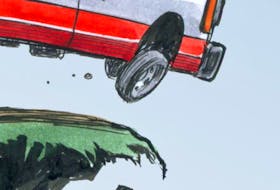The headline on a CBC story on Monday read “Five schools with combined enrolment of 89 students being considered for closure.”
The move would save $1.7 million a year, eliminate nine teaching jobs, and the schools involved are only a handful of the 20 schools being reviewed.
That, friends, is a sign of the times — and while it may concern you as a parent, (especially a parent in rural parts of the province), you will have to get used to it.
The student numbers are only likely to get smaller.
Here’s why: just two parts of the provincial government’s responsibilities, health and education, are responsible for more than half of the province’s total spending.
For every dollar that the provincial government spends, a combined total of more than 61 cents is spent on provincial support for health, education and post-secondary education.
The province is in a fiscal crunch; we owe so much money that the second-highest area of government spending is on debt expenses, and that spending — which can’t be avoided because we’re living well beyond our means and have to keep borrowing more and more — now tops a billion dollars a year.
Health, which is the most expensive service in the province, can only grow: there are more and more demands on the system as our population ages and procedures and drugs continue to spiral upwards in cost.
That puts education firmly in the cost-cutting crosshairs.
Why?
Because, after health and debt expenses, education is the highest cost service in the province, and at the same time, it is the area where the trend is of a shrinking clientele.
In 2005-2006, there were 74,315 students in the education system across the province, with 5,485 teachers.
Last year, there were 66,323 students, an 11 per cent drop over 12 years. There were 5,222 teachers, meaning a drop in the number of teachers of only 4.8 per cent.
The student numbers are only likely to get smaller. The age group that constitutes parents and potential parents, without a huge influx of younger residents, is only likely to shrink as the general population continues to move out of child-bearing years.
Meanwhile, that same general population is moving into an age group that has more and more health-care needs.
So where is government more likely to squeeze? The area that’s shrinking, or the area that’s growing? (Not only that — who are the stronger traditional voters, as we head towards the next provincial election? Traditionally, it’s been older residents.)
You can make the point that, eventually, students are too far apart to have their schools consolidated — that, eventually, it just takes too long to bus kids to larger centres. Some argue we have reached that point already.
But if you were the government, looking to cut costs, you’d be looking at education.
It’s simple math.








